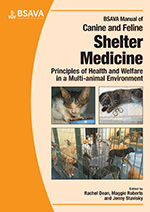
Full text loading...

Infectious diseases can be a major problem in the shelter environment. This chapter provides a very brief overview of the infectious agents that can cause disease, how the pathogens of importance are transmitted, and how they might be managed and treated.
Principles of infectious disease and transmission, Page 1 of 1
< Previous page | Next page > /docserver/preview/fulltext/10.22233/9781910443330/9781910443330.8-1.gif

Full text loading...














